Previously on Baxter Building: As Walt Simonson’s run on Fantastic Four continued, Jeff and I continued to get disillusioned with Walt Simonson’s run on Fantastic Four. Or, at least, I did; Jeff was never particularly illusioned to begin with. It’s very possible that the teenage me who first read these comics was easily distracted by (admittedly amazing) artwork.
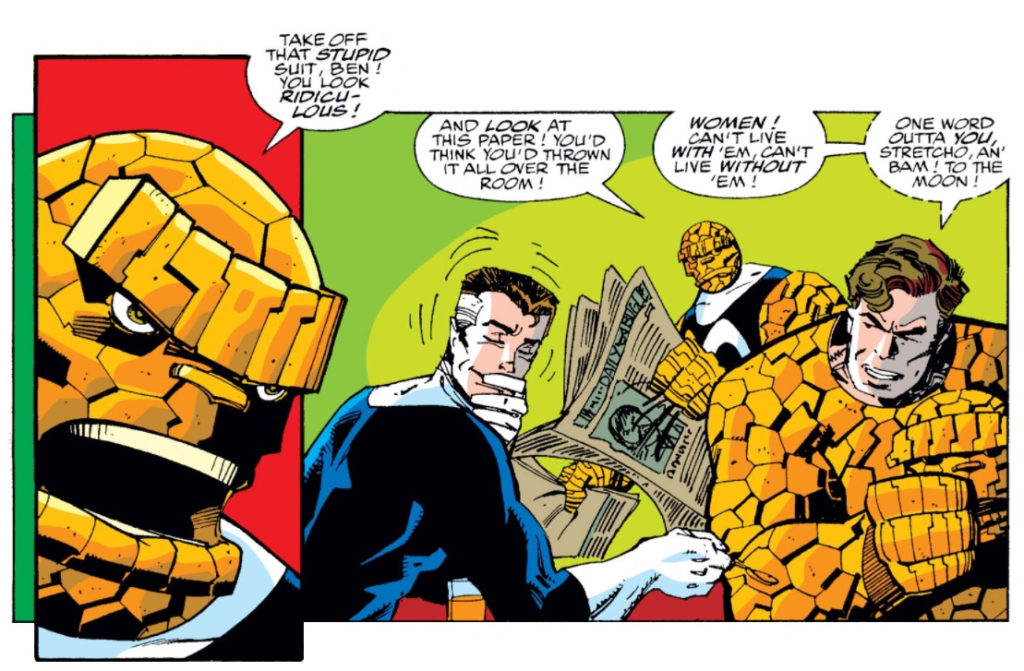
0:00:00-0:04:23: And so we return and begin again, introducing the issues we’re talking about this episode — Fantastic Four #350-355, AKA the final Simonson issues and two fill-ins — and once again, fail to get quite as excited about them as Whatnauts would like us to be. (I’m sorry. Honest.)
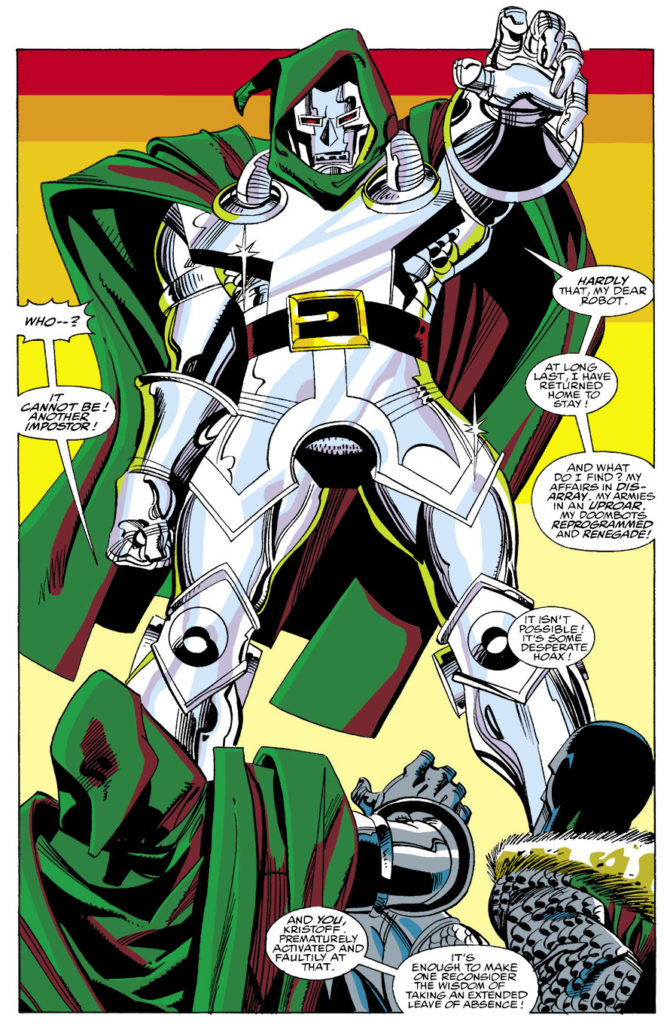
0:04:24-0:40:39: Fantastic Four #350 resolves a plot line that many had probably forgotten about — which Doom will rule Latveria? — in a manner that’s at once bold, exciting and endlessly frustrating, sending Jeff and I off on a discussion about what might be one of the most annoying issues of the entire Simonson run, on a number of levels. What price continuity? What price not putting in passive aggressive digs at other creators? We get into both questions, as well as quite how cool new Doctor Doom is, and quite how dumb this issue turned out to be. The discussion also includes, unexpectedly, towards Simonson’s weakness when it comes to drawing Sue Richards, but there are things that we like about it too, really. Also included: Is Baxter Building formally unkind to writers coming in and trying something new?
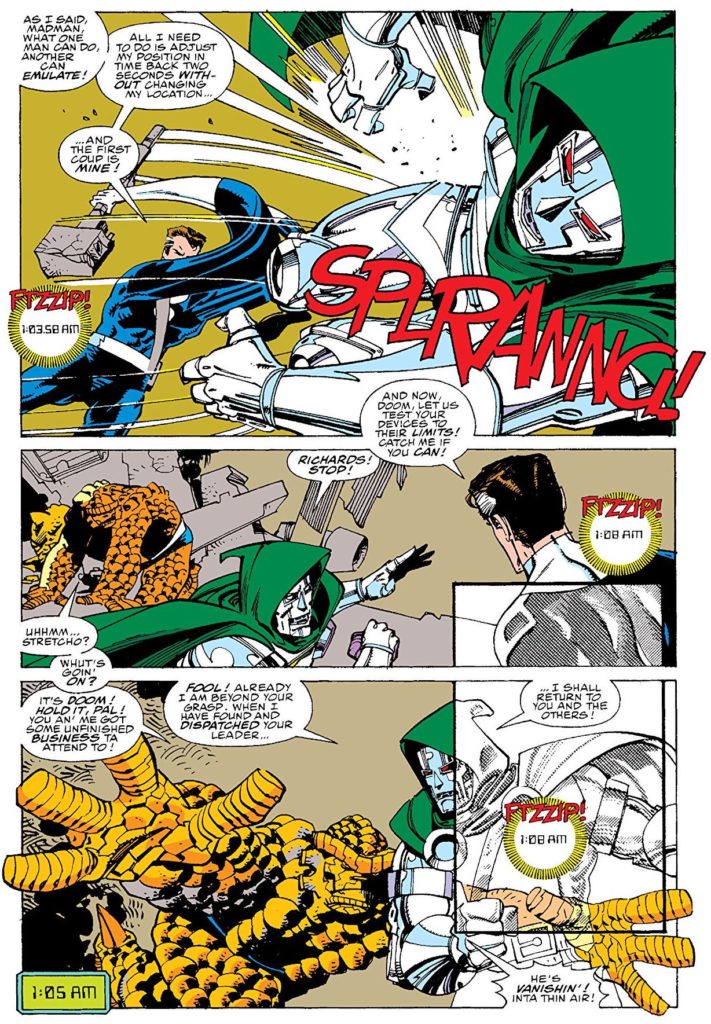
0:40:40-0:54:57: The clash between Doom and the FF continues in Fantastic Four #352 — we’ll get to #351 eventually, it’s a fill-in — and the formal play of the time-traveling issue manages to win us over for a while, even if I remain hung up on the portrayal of certain characters. But formalist play in such a heavy dose? No wonder Jeff says that it’s a “stunning issue” with complete reverence. Is this the first Simonson issue that passes the Lester test?!?
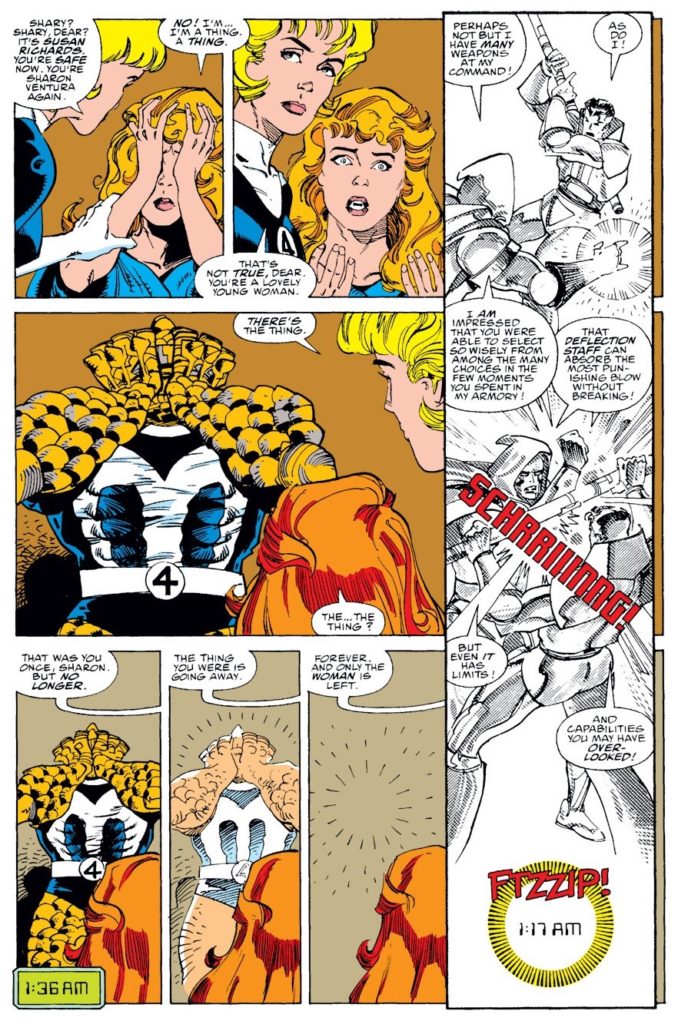
0:54:58-1:10:09: The discussion strays into an area of how I respond to these issues now, compared with when I first read them, and how strongly nostalgia plays into the appeal of them in general… which itself leads into a conversation about whether the Simonson run really counts as one of the top Fantastic Four eras, and if so, what that says about the series — and the concept — as a whole. (Spoilers: Not good things, really.)
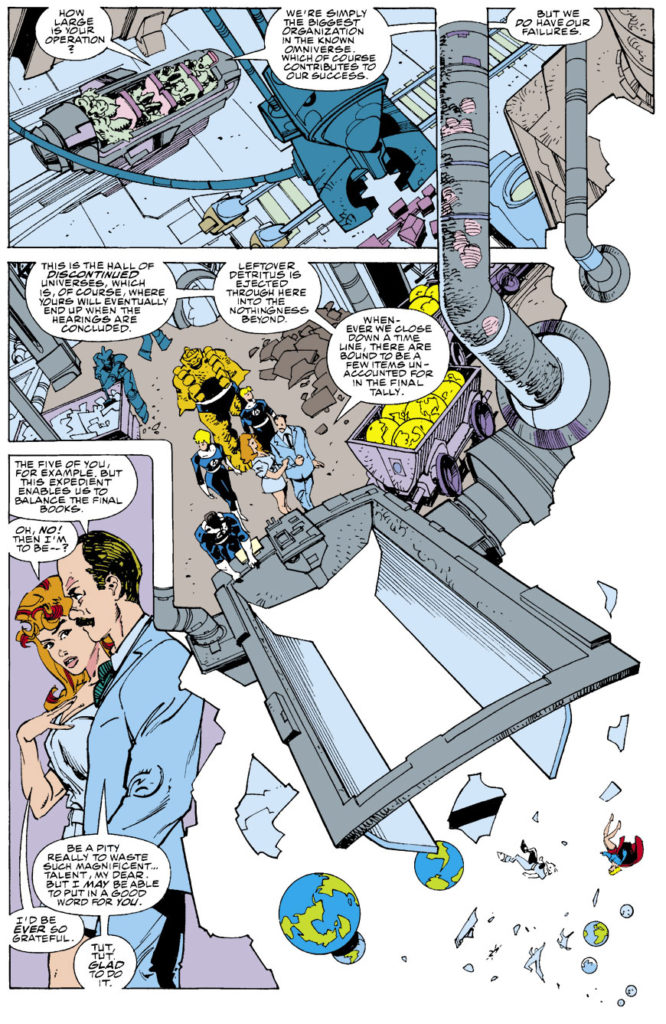
1:10:10-1:23:23: We get back on track by going through FF #353, in which Mark Gruenwald stands revealed as the villain behind the entire thing and Jeff and I struggle with whether or not formal playfulness and nice artwork can make up for shoddy writing, and consider whether or not this storyline was an inspiration for Alan Moore, of all people. But at least things end with a cliffhanger that isn’t even convincing for a second. It really does look great, though, especially the new new look Thing.
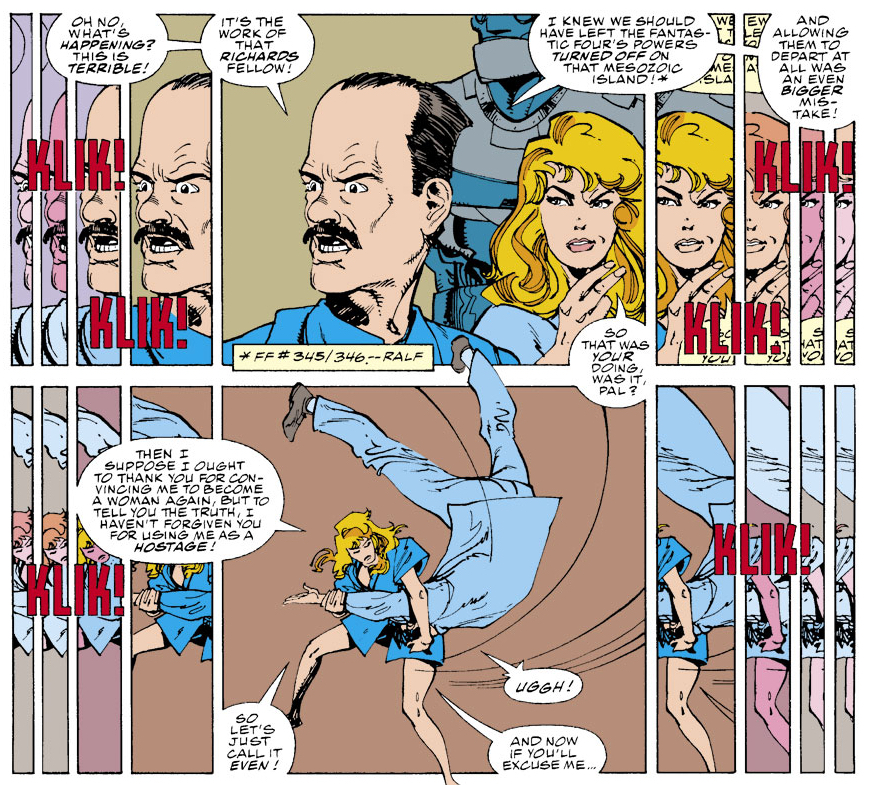
1:23:24-1:37:37: Fantastic Four #354 brings the end of the Walter Simonson era, and he goes out with a whimper that references Back to the Future Part III and has Jeff and I wondering if an alien is D.R., Quinch or Bug from Micronauts. Also, is there a not-so-hidden Excalibur reference in here, and what the hell is going on with the FF stripping down at the end of the issue? It’s… definitely an end to Simonson’s run, at least.
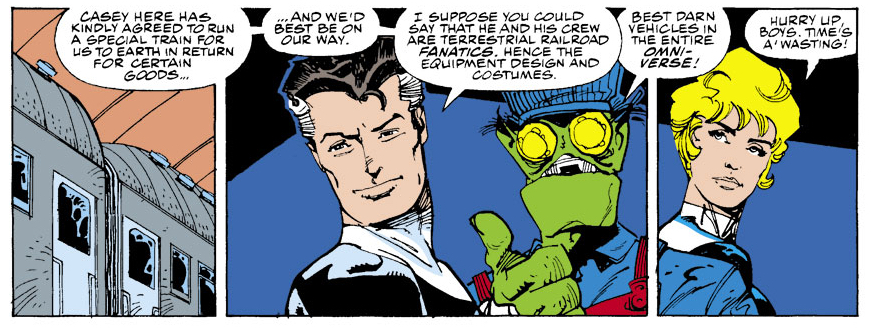
1:37:38-1:49:19: A brief look back at Simonson’s run brings up my (mistaken?) belief that these comics somehow predict Grant Morrison’s JLA a handful of years later, and we compare the two, with Jeff unpicking my thought process and coming up with better reasons for it to make sense — as much as it makes sense — and ways in which the comparison falls down. We also, very briefly, touch on whether Simonson’s Fantastic Four has made us want to (re-)read his Thor any more or less.
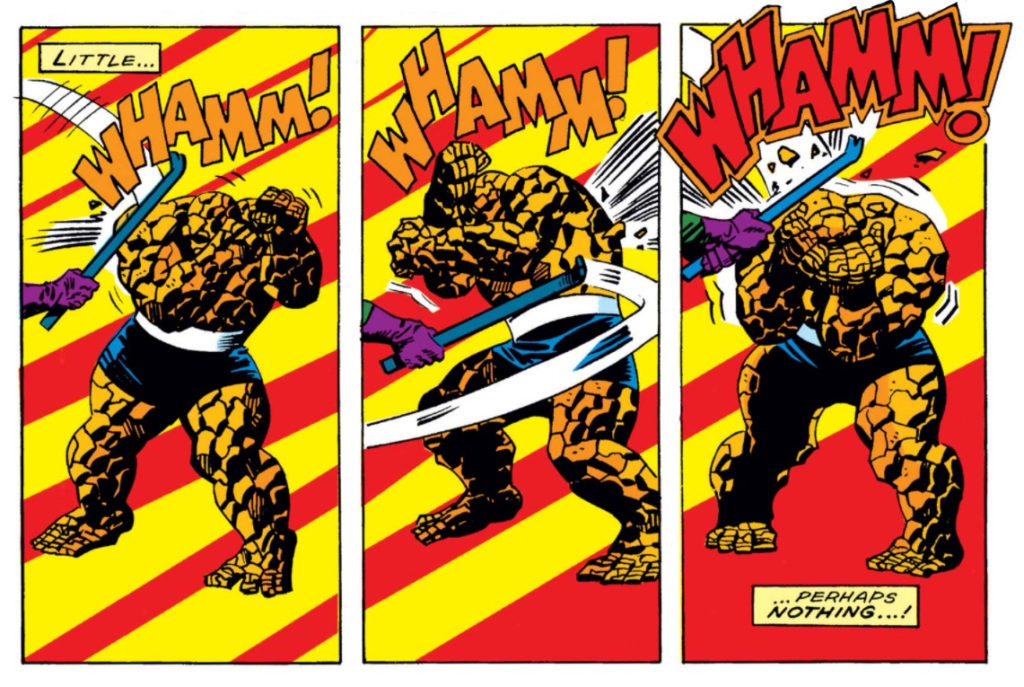
1:49:20-2:03:09: After exhausting ourselves on almost two hours’ worth of conversation about four comics — I don’t even think we talked about Lee and Kirby issues to this length — we gloss over Fantastic Four #s 351 and 355, both fill-in issues and both lacking even by the standards of what’s surrounding them, although Jeff and I surprised ourselves with a newfound appreciation of the artwork of Al Milgrom in #355, accompanying a story that is genuinely incredible, and not in a good way.
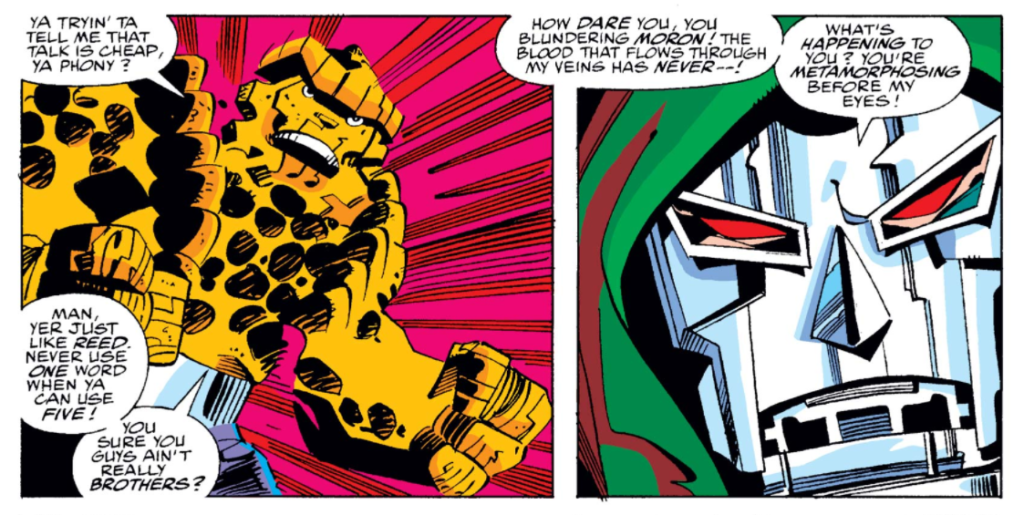
2:03:10-end: We wrap things up by announcing what we’re reading next — Fantastic Four Annual #s 19, 22-24 — and reminding everyone about the Twitter, Tumblr and Patreon of it all. As always, thank you for listening, and as with the last few episodes, we’re sorry we didn’t like Simonson as much as either of us wanted. (Although, judging by Jeff’s “I told you so”s this episode, maybe Jeff’s not that sorry…)


And for those looking for the direct download link… http://theworkingdraft.com/media/podcasts2/BaxterBuildingEp40.mp3
Thanks for a really enjoyable and interesting take on these issues. Let’s get the less pleasant stuff out of the way: a re-read of Simonson’s Thor will not improve your opinion of how he writes women. Perhaps like me you have remembered how much of a badass he presents Sif as? This is enjoyable and there, but Sif, like all other adult women in that run, is primarily motivated by lurve. Volstagg’s daughter Hildy comes off best, so maybe there’s a window before puberty where you can have a life which isn’t all about the guys.
Al Milgrom’s anagramatic pseudonym seemed a nod towards Starlin and later Byrne doing that. Just a little fun. I liked his inks on #350. They were faithful, but brought a warmth to the pictures some other Simonson inkers don’t. Simonson must do very full pencils when he knows he’s going to be inked by someone else, because the pencils I’ve see when he inks himself are pretty loose..
As much as I enjoy the idea that Doom hasn’t been back since The Battle of the Baxter Building, Simonson acknowledges it isn’t so. Silver Doom knows Kristoff. The kindest construction on that bit is it’s like the Doom / Rama Tut scene, the whole (ahem) wait, what? of it.
There’s an odd coincidence in you using ‘Don’t Ask, Just Buy It!’ as a description of the writing style in these final issues. That blurb appears on the cover of the second Goody Rickles Jimmy Olsen comic. My first encounter with Mark Gruenwald was a couple of issues later, when he wrote a letter saying he would be ashamed to let his father see such a silly comic and he hoped Mr Kirby would get back to writing sensible comics. I’m suddenly asking himself if Gruenwald’s tidying of the Marvel Universe was motivated by trying to please his father. Aren’t we humans odd. Oh and Casey? Angry Charlie, guys, Angry Charlie.
I’m less attached to continuity than either of you. As I have followed series when creators I liked were on them, or new ones caught my eye, there are lots of gaps in my reading. As a youngster, cash was the limiting factor, now it’s time. It’s been the rise of podcasts like yours which have led me to read mediocre runs of comics. I like light, witty continuity and dislike comics which become driven to sort out things like the origin of Hawkman. I’d agree it should be considered though, and the treatment of Sharon looks careless. Matt Fraction’s Hawkeye has so much payoff for me that I just shrug off the clear continuity break, but there’s none of that for Sharon.
I have just imagined the Watcher intoning ‘What if Fantastic Four volume 1 had ended at #355?’ and the pair of you skipping across a sunlit field in a shower of petals.
I don’t want you guys to move on to another book. I want to hear you go through Jim Lee FF. Oh the things you would have to talk about in Claremont’s run! The fun of Waid’s run.
Oh well, I guess I will enjoy whatever you guys choose and maybe come back for a Baxter Building Redux and pick up where you left off someday…..
I wonder how much of the writing shitting on Englehart and Byrne’s stuff was editorially mandated. IIRC Simonson was brought in to fix the mess that editorial perceived was the state of the Fantastic Four. I also think Simonson’s primary reason for leaving Marvel was editorial interference that he felt marred his stints on FF and the Avengers.
And for what it’s worth, I love Days of Future Present. Sure, that’s partly because I read them on a childhood summer vacation and have happy memories attached. That said, I revisited the a year ago and really loved them. It’s a crossover that addresses continuity issues by turning the feelings of defunct characters into a surreal Claremontian nightmare (though it’s mostly written by Louise Simonson). Plus Bogdanove draws the X-Factor issue!
Regarding Walter Simonson and Thor, I think his run has some serious problems with women. The characters are either loyal to a man or conniving for someone’s love. Also, most of the male characters are more prominent and important. In other words, it’s a very male-dominant book. I don’t know if you’ve had a chance to listen to Miles Stokes and Elisabeth Allie’s mini-podcast “The Lightning and the Storm,” but this is definitely something they noticed during the run. Link here: https://www.thelightningandthestorm.com
By the way, even without reading the issues, I immediately thought of the Captain Britain Corp during your discussion of the Time Variance Authority. Even before you got to the train, it definitely felt like some Cross-Time Caper stuff.
Given the interplay between Thor, Power Pack and the X books while Claremont and the Simonsons are in charge there seems to be a closer than usual continuity between those titles. As a reader (and this is very subjective), it came across as friendly. Like they were playing nice with each others things and it wasn’t the result of editorial mandate.
Loving the show, guys. I’ve always had extremely mixed feelings about the Simonson run, so glad to hear I’m not alone in that since it’s usually universally praised.
Any chance of you covering the Claremont/Bogdanove X-Men/FF crossover? It features one of the more likeable-yet-retroactively dickish interpretations of Reed thus far, “Rogue-Thing,” Ben terrifying a diner full of people with his binge-drinking and Doom attempting to eat caviar through his mask. I figure it might be a pleasant break during the upcoming DeFalco/Ryan painfest.